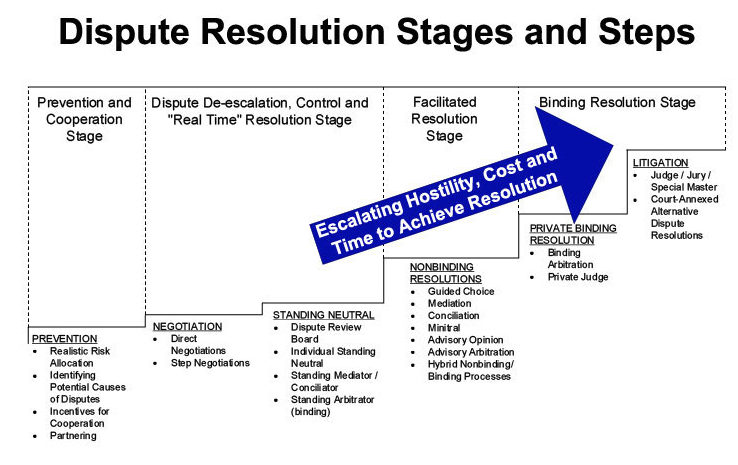Today, because of the flexibility, adaptability and versatility of ADR, Users of dispute resolution processes have available to them a wide variety of techniques that can be used to prevent, control and resolve disputes. New techniques are constantly being developed to deal with the wide variety of potential disputes that can occur in any kind of relationship, and at any stage in the development or escalation of a problem or dispute.
It has become increasingly common for parties about to enter into a relationship to combine a series of dispute prevention, control and resolution processes into a ‘system’ or series of ‘steps’ that are designed to deal with different kinds of problems or disputes that might occur, at successive stages in the development and escalation of a dispute. These processes can be grouped for convenience into four broad categories or stages:
The Prevention and Cooperation Stage, where parties can use prevention and cooperation techniques, tailored to encourage alignment of interests, improve cooperation, prevent or minimise the adverse impact of problems, and curb adversarial attitudes.
The Dispute De-Escalation, Control and ‘Real Time’ Resolution Stage, where parties can use techniques that are designed to deal promptly and realistically with problems, differences of opinion or disagreements at the time they arise, to de-escalate tensions, resolve problems, or achieve instant resolution of disputes.
The Facilitated Resolution Stage, where parties, assisted and guided by mediators and other dispute resolution professionals, can use any of a wide variety of techniques, or combinations of techniques, to achieve a mutually-acceptable resolution of a dispute.
The Binding Resolution Stage, where, after all other efforts at resolution have failed, parties can have a ‘back stop’ adjudication process in which the dispute will be finally resolved by a neutral third party — either in a privately-agreed process such as arbitration, or, by default, in a court of law.
These stages are graphically illustrated in the attached Chart of Dispute Resolution Stages and Steps, which lists various techniques in the order in which they would normally be employed in the life of a dispute, and demonstrates, in dramatic ‘stair step’ fashion, escalating degrees of hostility, cost, and time for achieving resolution, from stage to stage, as an unresolved dispute progresses.
